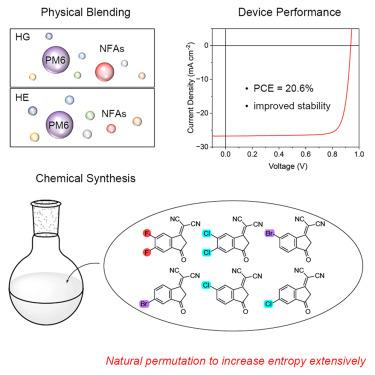Efficient and stable high-entropy organic photovoltaics
IF 38.6
1区 材料科学
Q1 CHEMISTRY, PHYSICAL
引用次数: 0
Abstract
The lack of simultaneous high efficiency and long-term stability in organic photovoltaics (OPVs) poses a major challenge to commercialization. Here, we introduce a high-entropy (HE) methodology by both physical blending and chemical synthesis, where multiple components are mixed to improve system entropy. Our findings show that physically blended HE blends maintained strong π–π interactions due to acceptors’ identical backbones. The different halogens or alkyl chains reduced structure order and fostered an optimal mixture, where a redistribution of the conduction-band density of states was found, leading to a higher effective band gap, reduced non-radiative recombination, and elevated open-circuit voltage. This HE design rule was then extended to chemical synthesis to make HE materials, which yielded a maximum power conversion efficiency of 20.6% (20.3% ± 0.2%, certified as 20.0%) in OPV devices. Moreover, both operational and thermal stability were improved, measured in conventional encapsulated devices under continuous illumination.

求助全文
约1分钟内获得全文
求助全文
来源期刊

Joule
Energy-General Energy
CiteScore
53.10
自引率
2.00%
发文量
198
期刊介绍:
Joule is a sister journal to Cell that focuses on research, analysis, and ideas related to sustainable energy. It aims to address the global challenge of the need for more sustainable energy solutions. Joule is a forward-looking journal that bridges disciplines and scales of energy research. It connects researchers and analysts working on scientific, technical, economic, policy, and social challenges related to sustainable energy. The journal covers a wide range of energy research, from fundamental laboratory studies on energy conversion and storage to global-level analysis. Joule aims to highlight and amplify the implications, challenges, and opportunities of novel energy research for different groups in the field.
 求助内容:
求助内容: 应助结果提醒方式:
应助结果提醒方式:


